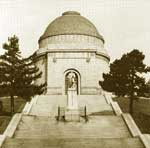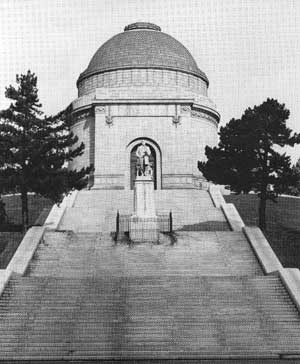






Survey of
Historic Sites and Buildings
 |
McKinley Tomb Ohio |
 McKinley Tomb |
| ||
Except for the White House, no other McKinley residence is extant. This tomb, in the city he was closely identified with throughout his adult life, is the only structure that is significantly associated with him. Following his death by an assassin's hand in 1901 at Buffalo, his body was temporarily interred in Westlawn Cemetery, where this memorial mausoleum was to be erected. It was dedicated in 1907, the year his wife succumbed and was buried with him.
The tomb stands on a 75-foot-high, grass-covered hill overlooking the city of Canton. It is circular and domed, has a pink granite ashlar exterior, rises 96 feet above the ground, and measures 79 feet in diameter. Designed by Harold Van Buren Magonigle and financed by public subscription, it cost $558,452.91.
The floor of the mausoleum is formed by different-hued marble laid in a cross pattern. At the center, two polished, dark-green, granite sarcophagi, resting atop a 10-foot-square polished dark maroon granite base, contain the bodies of McKinley and his wife. Each axis of the cross pattern on the floor leads to a semicircularly arched recess or bay. Each arch has a keystone, on which an eagle is sculptured. Doric columns flank each bay and support an entablature and frieze that extend around the bottom of the dome and bear an inscription from McKinley's last speech. Light-gray marble faces the interior walls.
 |
| McKinley Tomb. (National Park Service, George R. Adams, 1974.) |
The exterior of the double-walled tomb, whose platform measures 178 feet in diameter, is little ornamented. Festoons of ivy decorate the frieze, and a civic crown with a laurel wreath of gilded bronze surmounts the dome. Entrance is through huge double bronze doors which are set in a semicircularly arched opening. Each door measures 12 by 24 feet.
Originally a reflecting pool stretched some 750 feet from the base of the hill to the 108 stone steps leading to the tomb. The pool and steps were intended to symbolize the blade of the President's sword in time of war. A depressed lawn replaced the pool during the 1930's, but the sword effect remains. A tree-lined drive passes around the pool site to a parking area at the foot of the tomb. Midway up the steps, on a 13-foot-high pedestal, is a 9-1/2-foot-high bronze statue of McKinley delivering his last speech in Buffalo. The work was rendered by Charles H. Niehaus.
The William McKinley Memorial Association owned and maintained the tomb until 1943, then turned it and approximately 20 surrounding acres over to the State. The Stark County Historical Society acquired the memorial in 1973.
 |
 |
http://www.cr.nps.gov/history/online_books/presidents/site49.htm
Last Updated: 22-Jan-2004